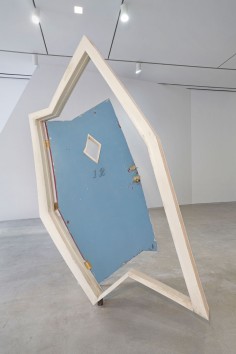Robert Lazzarini
罗伯特·拉扎里尼
РОБЕРТ ЛАЗЗАРИНИ
motel door
source: museomagazine
Robert Lazzarini’s artwork springs from a desire to understand the perceivable limits of the material world. Conceptually and formally rigorous, he pushes ordinary objects to their limits by mining the twined threads of distortion and material veracity. By fully devoting himself to these indispensable characteristics, Lazzarini negotiates a place between two and three dimensions that challenges his viewers’ understanding of the physical world and their visual perception.
Though often mistaken for mere anamorphism, Lazzarini’s work is in fact affected by multiple mathematical distortions so that his pieces elude finite conclusions and deny normative reads. The resultant uncertainty is balanced by a truth to materials: violin (1997) is composed of wood and bone; phone (2000) of plastic, metal, and rubber; skulls (2000) of reconstituted bone; and so forth. For Lazzarini, the use of direct materials emphasizes the tension between plausible and implausible.
In Lazzarini’s most recent exhibition, guns and knives at the Aldrich Museum of Art, he has turned his attention forward in two significant ways. The first is a shift within the sculptures, which for the first time conflate multiple objects to further complicate and abstract the forms. The second is an alteration of the actual gallery itself, whose walls are canted at varying angles to subtly disrupt the viewer’s apprehension of the physical space and further offset the distortions of the works themselves. Add to this a new set of prints produced during a visual arts fellowship at the Neiman Center for Print Studies at Columbia University and a forthcoming exhibition at Deitch Projects, it seemed an apposite time to talk with Lazzarini about where his work has come from and what might happen next.
.
.
.
.
.
.
.
source: designboom
american artist robert lazzarini disrupts a viewer’s habituated process of visual recognition through creating distorted, skewed 3-dimensional objects.
the pieces depict ordinary items which seem to slip from two to three dimensions as one moves around the volume, each created through compound mathematical contortions based on algorithmic operations such as mappings and translations. there are two main types of malformations at work in lazzarini’s sculptures – planar and wave – where both effects position the object in a state of limbo between familiarity and the unknown.
.
.
.
.
.
.
.
source: 3domen
Американский художник Роберт Лаззарини (Robert Lazzarini) создает уникальные скульптуры узнаваемых объектов, искажая их, казалось бы, невозможными способами. Используя алгоритмический процесс, Лаззарини искажает знакомые объекты. Его цель — создание иллюзии расширения материального мира и изменение обычного зрительного восприятия человека.
Все свои скульптуры Лаззарини создает из тех же материалов, что и вещи на которых они основаны. Например, трехмерный череп, впервые выставленный в экспозиции Музея Американского искусства Уитни, был создан из литой кости.


